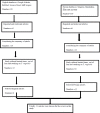Medicinal Plants with Anti- Trichomonas vaginalis Activity in Iran: A Systematic Review
- PMID: 31123463
- PMCID: PMC6511599
Medicinal Plants with Anti- Trichomonas vaginalis Activity in Iran: A Systematic Review
Abstract
Background: Trichomoniasis, due to Trichomonas vaginalis, is one of the most common sexually transmitted parasitic diseases in the world such as Iran. This systematic review aimed to explore the studies evaluating the medicinal herbs with anti-T. vaginalis activity which used in Iran.
Methods: Articles published in 4 Persian and 4 English databases were obtained between 2000 and 2015 including Google Scholar, PubMed, Science Direct, Scopus, Magiran, Barakatkns (formerly IranMedex), Elm net, and SID (Scientific Information Database). Studies out of Iran, studies on animal models and articles on other parasite species than T. vaginalis were excluded from this review.
Results: Twenty-one articles including in vitro experiments, met our eligibility criteria. Thoroughly, 26 types of plants were examined against T. vaginalis. Medicinal herbs such as Artemisia, Zataria multiflora, and Lavandula angustifolia are remarkably effective on T. vaginalis. As such, use of other parts of these plants in different concentrations and timelines is recommended for future in vivo studies.
Conclusion: The present systematic review provides comprehensive and useful information about Iranian medicinal plants with anti-T. vaginalis activity, which would be examined in the future experimental and clinical trials and herbal combination therapy.
Keywords: Iran; Medicinal plants; Systematic review; Trichomonas vaginalis.
Conflict of interest statement
Conflict of interest The authors declare that there is no conflict of interests.
Figures
Similar articles
-
Medicinal plants with promising antileishmanial activity in Iran: a systematic review and meta-analysis.Ann Med Surg (Lond). 2017 Jul 27;21:63-80. doi: 10.1016/j.amsu.2017.07.057. eCollection 2017 Sep. Ann Med Surg (Lond). 2017. PMID: 28794869 Free PMC article. Review.
-
Review of Trichomonas vaginalis in Iran, Based on Epidemiological Situation.J Reprod Infertil. 2018 Apr-Jun;19(2):82-88. J Reprod Infertil. 2018. PMID: 30009141 Free PMC article. Review.
-
The prevalence of Trichomonas vaginalis infection among the female population of Iran: a systematic review and meta-analysis.Int Health. 2024 May 1;16(3):240-251. doi: 10.1093/inthealth/ihad059. Int Health. 2024. PMID: 37555353 Free PMC article.
-
A Systematic Review of the Effects of Satureja Khuzestanica Jamzad and Zataria Multiflora Boiss against Pseudomonas Aeruginosa.Iran J Med Sci. 2020 Mar;45(2):83-90. doi: 10.30476/IJMS.2019.72570.. Iran J Med Sci. 2020. PMID: 32210484 Free PMC article. Review.
-
Therapeutic effects of Iranian herbal extracts against Trichomonas vaginalis.Iran Biomed J. 2017 Sep;21(5):285-93. doi: 10.18869/acadpub.ibj.21.5.285. Epub 2017 Jul 30. Iran Biomed J. 2017. PMID: 28755655 Free PMC article.
Cited by
-
Biological Activities of Essential Oils from Leaves of Paramignya trimera (Oliv.) Guillaum and Limnocitrus littoralis (Miq.) Swingle.Antibiotics (Basel). 2020 Apr 24;9(4):207. doi: 10.3390/antibiotics9040207. Antibiotics (Basel). 2020. PMID: 32344551 Free PMC article.
-
Bioactive Compounds as Potential Agents for Sexually Transmitted Diseases Management: A Review to Explore Molecular Mechanisms of Action.Front Pharmacol. 2021 Aug 24;12:674682. doi: 10.3389/fphar.2021.674682. eCollection 2021. Front Pharmacol. 2021. PMID: 34504422 Free PMC article. Review.
-
Induction of apoptosis by hydroalcoholic and methanolic extract of Deracocephalum kotschyi on Trichomonas vaginalis.J Parasit Dis. 2022 Sep;46(3):686-694. doi: 10.1007/s12639-022-01482-6. Epub 2022 Apr 23. J Parasit Dis. 2022. PMID: 36091285 Free PMC article.
-
Anti-trichomonad activities of different compounds from foods, marine products, and medicinal plants: a review.BMC Complement Med Ther. 2020 Sep 9;20(1):271. doi: 10.1186/s12906-020-03061-9. BMC Complement Med Ther. 2020. PMID: 32907567 Free PMC article. Review.
-
Antibacterial, Trichomonacidal, and Cytotoxic Activities of Pleopeltis crassinervata Extracts.Pharmaceutics. 2024 May 7;16(5):624. doi: 10.3390/pharmaceutics16050624. Pharmaceutics. 2024. PMID: 38794287 Free PMC article.
References
-
- Hezarjaribi HZ, Fakhar M, Shokri A, Teshnizi SH, Sadough A, Taghavi M. Trichomonas vaginalis infection among Iranian general population of women: a systematic review and meta-analysis. Parasitol Res. 2015; 114(4):1291–300. - PubMed
-
- Wølner-Hanssen P, Krieger JN, Stevens CE, et al. Clinical manifestations of vaginal trichomoniasis. JAMA. 1989; 261(4):571–6. - PubMed
-
- Johnston VJ, Mabey DC. Global epidemiology and control of Trichomonas vaginalis. Curr Opin Infect Dis. 2008; 21(1):56–64. - PubMed
-
- Shiadeh MN, Niyyati M, Fallahi S, Rostami A. Human parasitic protozoan infection to infertility: a systematic review. Parasitol Res. 2016; 115(2):469–77. - PubMed
Publication types
LinkOut - more resources
Full Text Sources
Research Materials
Miscellaneous

